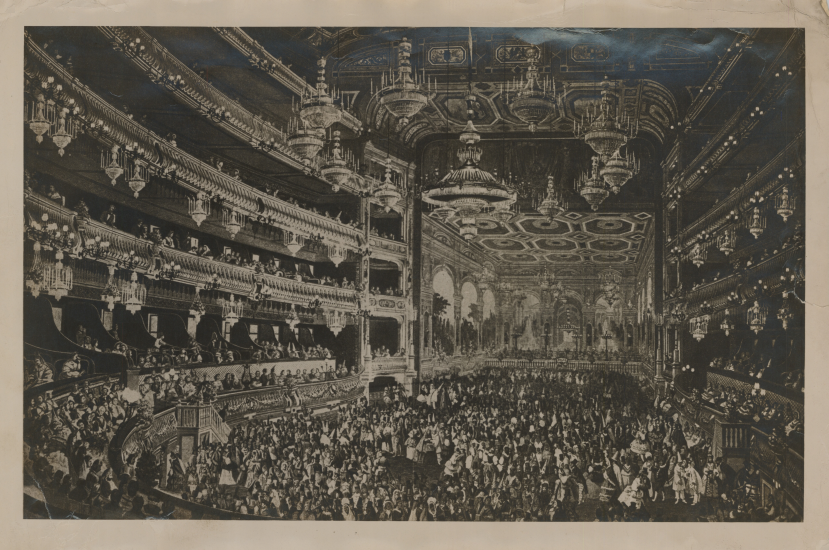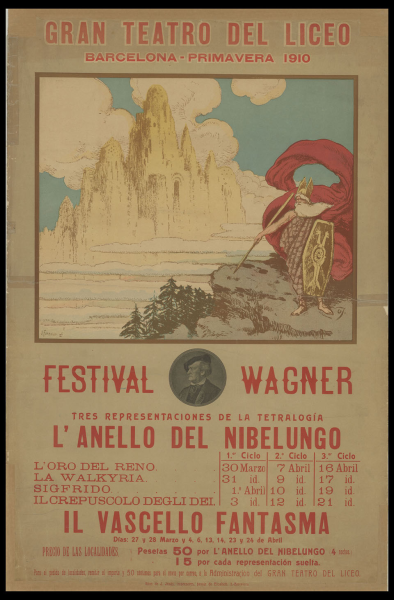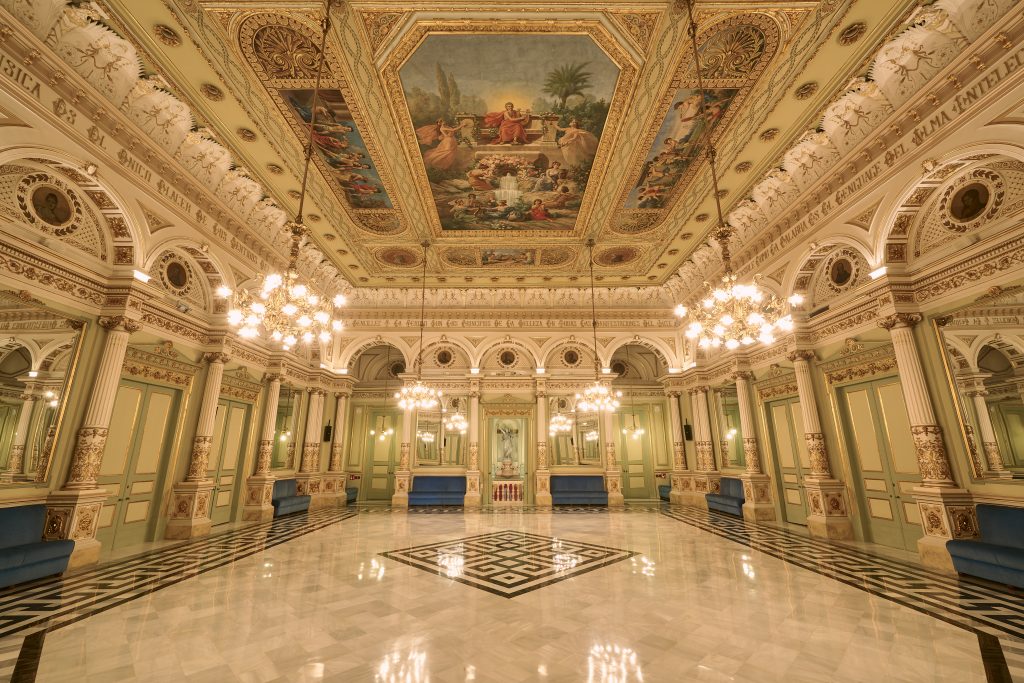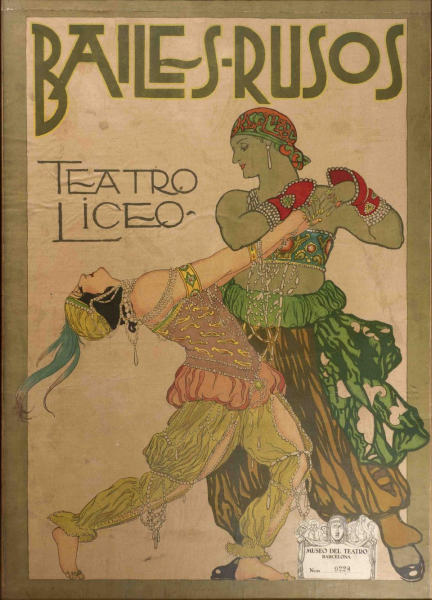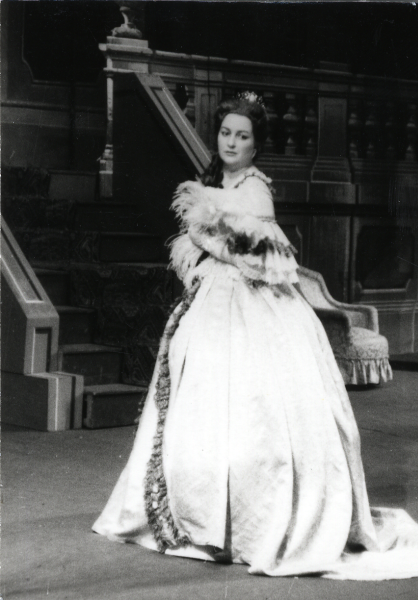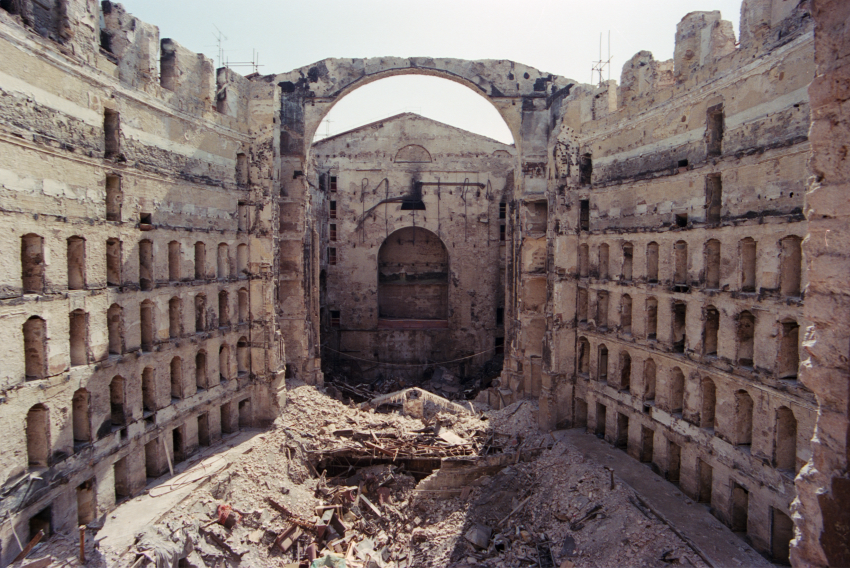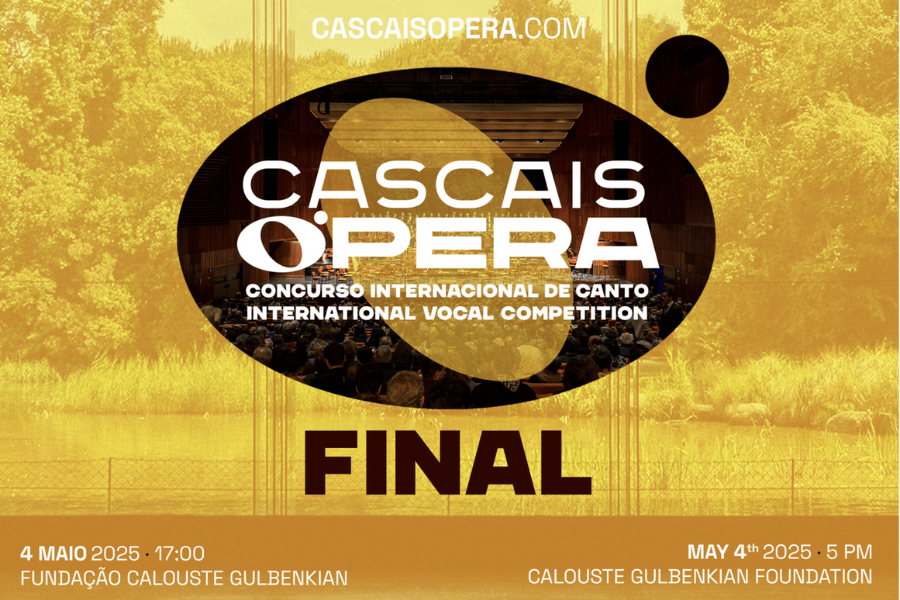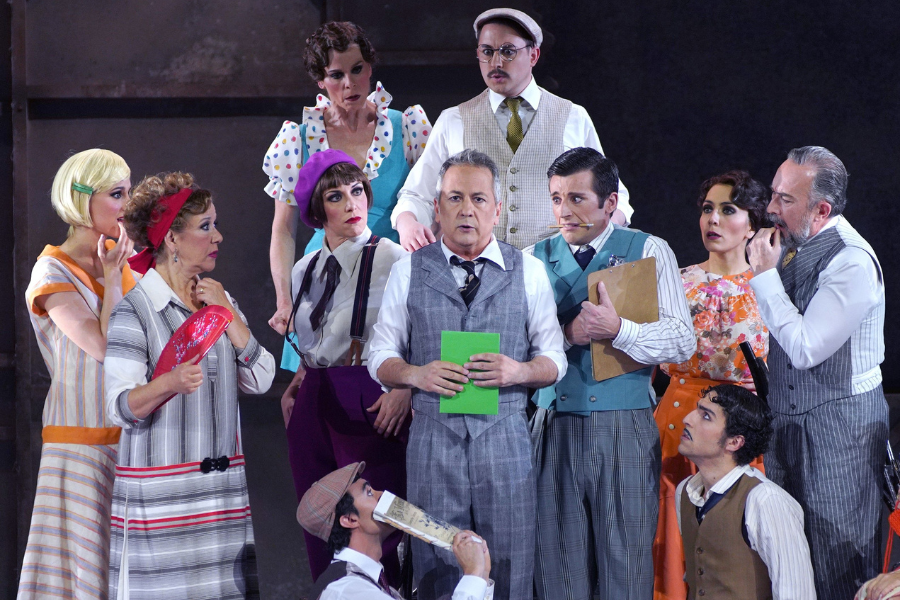Theater of the Month: The different lives of the Gran Teatre del Liceu
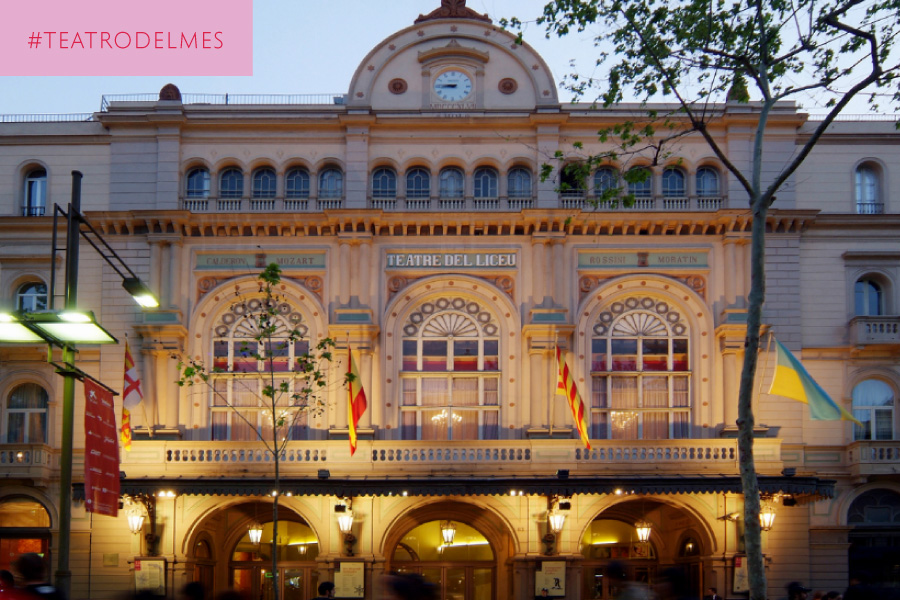
Barcelona’s iconic theater is the city’s main opera house. It is not only recognized for the grandeur of its architecture or the prestige of the productions and singers that have passed on stage. Throughout history and since its inauguration in 1847, the Liceu has survived fires and deep processes of social transformation. Resilience has become one of the main characteristics of this colosseum, rising again to continue being a renowned institution in culture, entertainment and the international lyrical scene.
by Álvaro Molina
The Spanish nobleman and military man Jaime de Guzmán-Dávalos y Spínola, in a letter written in 1765 to the then governor of Lérida, with an eagerness to worship and patronage, described the love of the people of Catalonia for festivities and artistic shows. He referred to this society with laurels, rescuing its strategic importance for the Hispanic kingdom and the industriousness of its population. Beyond the political revenues, Guzmán-Dávalos y Spínola, Marqués de la Mina, highlighted the Catalan fascination for devotions, parties and shows. “[The Catalans] love, with their time, entertainment and just as Carnival is festive, they are devoted in Lent, and walks, dances, theaters are no less populated than churches and processions,” he wrote the marquis.
The Marquis de la Mina had fought in Italy. On military excursions he was enraptured by opera. This art had already begun to sound in Barcelona at the hands of Archduke Carlos of Austria, who in 1705 held a first performance at his court, choosing Il più bel nome, by Antonio Caldara, to inaugurate the lyrical hobby in the region. With the return of the Marquis de la Mina, the opera was regularly installed at the Teatro de la Santa Cruz. Thus, a tradition began to be forged that a few decades later would be incorporated into Catalan culture, history and society.
The devotions expressed in Lent and Carnival, social festivities and a love of opera make up, among others, the pillars of the history of the Gran Teatre del Liceu in Barcelona. An epic framework in which political and social transformations converge, the narratives of European art and the expansion of the lyric as a spectacle that, little by little, has taken root in all social strata. Talking about the annals and chronicles of the Liceu is inseparable from the review of the different lives that, over the years, since its inauguration in 1847, were marked between its walls, rooms and its stage.
The seed of the fans
The origin of the Liceu dates back to a turbulent period in Spanish political history. The civil conflict of the First Carlist War (1833-1840) and the promulgation of a new Constitution by the regency of María Cristina de Borbón reconfigured the Spanish political map. The war also highlighted the profile of the National Militia, a body of armed citizens linked, at that time, to liberalism and the Progressive Party, and whose mission was to protect public order and defend the recently established liberal constitutional regime.
The National Militia, however, was not just a group of thugs in the service of governance. In 1837, a battalion of the corps, at the initiative of the military and lawyer Manuel Gibert, sowed the institutional seed of the Liceu in the disaffected Montsió convent. A new society of fans of the performing and lyrical arts had been born. The culturizing influence that, years ago, the Marquis de la Mina and Archduke Carlos of Austria initiated was resumed.
In this primitive stage, the Barcelonés Dramatic Philharmonic Lyceum (Liceu) was born, a project created by the original partners who wanted to go beyond aesthetic enjoyment and include an educational line in the arts for the Barcelona society of the time. Thus, a community of shareholders, contributors, supporters, students and subscribers to the seasons was formed that began to devise a future for the Theater.
This group kept its distance from the monarchy. Unlike other states in Europe, whose regencies promoted the construction of large and opulent theaters, the Liceu was financed exclusively by private companies such as construction companies and well-to-do families who, in exchange for the subsidy, received perpetual discounts and payments on seats and boxes.
The only thing missing was a new location to host the growing teaching chairs and the new theatrical shows. In 1844, Joaquín de Gispert y de Anglí, a member of the Liceu, chose the old Trinitarios convent, on the Rambla, to formally begin the first life of the Theater.
A first life between bel canto and the grand opera
Construction of the new Theater began in April 1845, in a project initiated by the architect and urban planner Miquel Garriga i Roca, an illustrious son of the province of Barcelona, author of topographic plans of the city and the facade of the Mataró City Hall. Garriga directed the works until the following year, in which he was replaced by Josep Oriol Mestres, a renowned architect who integrated new technical guidelines under the auspices of Josep Casademunt’s teachings at the School of Noble Arts in Barcelona. The late neoclassical style and the stream of functionalism of the rationalist school extended by Europe in the first half of the 19th century were the routes that Oriol Mestres followed in his career as an architect and that, later, would define the identity of the Liceu infrastructure.
On Sunday April 4, 1847, Barcelona celebrated Easter. The merriment and devout spirit of the citizens flooded the inauguration of the Gran Teatre del Liceu. The expectation of Barcelona society found a foothold in the shows scheduled for the date. The performance would begin with a symphony by Juan Melchor Gomis, it would continue with the drama Don Fernando el de Antequera from Ventura de la Vega, and then give way to the Andalusian-style dance La Rondeña (work by Josep Jurchen and choreography by Joan Camprubí). Finally, Il regio Imene would take place, a cantata in Italian by Joan Cortada set to music by Marià Obiols. A few weeks later it would be the opera’s turn, the first to be presented at the Theater. The chosen one was Ana Bolena, by Gaetano Donizetti.
During this period, the demand for Italian opera and bel canto filled theaters around the world. Bellini, Donizetti and Rossini entered the Liceu’s programming as standards, to later receive Verdi’s works and form a repertoire that, later, would see the arrival of the French grand opera. The compositions of Halévy, Meyerbeer and Thomas had a -literal- place on the stage of the Liceu, which had the most modern technology of that time to host the grandeur of spectacular scenographies, immense choirs and ballet numbers, all in the same show .
But it was not only the opera that shone in the Theater. Zarzuelas, concerts, magic and tightrope, ballet and circus performances brought together the different strata of Barcelona society. The room was filled daily and the building became an icon for citizens.
On April 9, 1861, there was an abrupt end to the first chapter of this story. A fire started in the theater’s tailor shop. The flames spread rapidly and destroyed most of the building. The hall and the stage were in ruins. The owners and shareholders of the company agreed on a reconstruction in which the expenses would be distributed among all the people with interests to give a new life to the Theater. Josep Oriol Mestres was called back to direct the reconstruction work and, in an admirable task, that same year, a remodeled Liceu reopened its doors, giving a second life.
Convulsion and glory
One day in April 1862, the Liceu began a new chapter in its history. The doors were opened with the symphonic work Las dos tombidas, by Joan Sariols y Puerta, the winning composition of a competition called especially for the reopening. Later, the Italian opera would return with I puritani, by Bellini, which aroused joy in the audience and the organization.
The Theater was already positioned as the lyrical house with the largest capacity in Europe. The capacity for 3,500 spectators made it possible for it to receive audiences from all over. Diversity was present, but stratified; the boxes and the stalls accommodated aristocratic and bourgeois families, while on the floors above the lyrical fans gathered. At the top level the working class was convened. The articulation of the Liceu as a social gathering center was not limited only to operas and shows, but the people of the oligarchy and ruling class also congregated in masked balls, parades of wealth and opulence and instances to exchange ideas, close deals and consecrate marriages.
Conflicts between social forces, however, would soon erupt. The same Theater recounts a sad event in this chapter and that took place in 1893:
The fact that the Liceu became a symbol of the oligarchy made it the target of the revolutionary proletariat, which, at the end of the 19th century, was strongly influenced by Italian anarchist currents that used direct action or “propaganda for the done “as a means of struggle against the ruling classes. On November 7, 1893, in the inaugural performance of the season, during the second act of Guillermo Tell, the anarchist Santiago Salvador threw two Orsini bombs in the stalls, of which only one exploded, leaving 20 victims and a large number of injured. After that day, the Liceu closed its doors and did not return to artistic activity until January 18, 1894, with a series of concerts conducted by maestro Antoni Nicolau. The attack left a climate of fear among the bourgeoisie, so the boxes and seats would take time to fill up normally.
Before that event, however, opera continued its programmatic hegemony with the most avant-garde and ostentatious productions of that time. Wagnerism influenced the arts and politics of that time with the epic and fantasy language of Tannhäuser (in 1887 it arrived on the stage of the Liceu), the stories of gods and sorcerers in the Ring (The Valkyrie premiered in 1899), and the stories of Germanic romanticism with Tristán and Isolde (work that inaugurated the season of 1899-1900). This fervor, in which Wagner’s music and style intoxicated the spirit of the fin de siècle, continues to this day, with performances of Wagnerian dramas in almost every season at the Liceu.
During this period, as a kind of nod to the Catalan evocation of the festivities, the Theater began to structure its programming based on genres; winter was devoted exclusively to opera, while in the Lenten season concerts, ballet and operetta came to define the season. Finally, spring represented the public’s favorite operas and operettas.
This structure, likewise, also paved the way for works and singers from Catalonia to find their space at the Liceu. In 1885, the Theater premiered the opera El despair, by Artur Baratta. This local opera debut was joined by La messaggiera, by Sánchez Gavagnach; Lovers of Teruel and Garín, by Tomás Breton, Quasimodo and Los Pirineos by Felip Pedrell; and, before the nineteenth century came to an end, Isaac Albéniz directed Henry Clifford. In parallel to these compositions, some Catalan singers who would soon be internationally recognized made their debut on stage. To name a few: Francisco Viñas; Maria Barrientos; José Palet; Carmen Bonaplata; Elvira de Hidalgo, Graziella Pareto; Josefina Huguet, and Conxita Supervia.
With the advent of the 20th century, the popularity of Russian opera, Sergei Diaghilev’s ballets and the Russians of Monte Carlo spread, as well as the iconic dancer Anna Pavlova. In parallel, the operas by Rimsky-Korsakov and Tchaikovsky, as well as concerts by Stravinsky, also began to gain fans on the Barcelona stage. The ballet would remain a favorite with the Vienna and Paris companies during the 1920s, at the same time as the Lenten concerts.
The socio-political hinge that the rise of the Republican Generalitat in 1931 meant was translated into the incentive to program works by Catalan authors, such as the premiere of Nerón and Acté by Joan Manén. Around 1938, the only Catalan opera premiered that survives to this day in the Liceu catalog is El giravolt de Mayo, composed by Eduard Toldrà with a libretto by Josep Carner. With the outbreak of the Spanish Civil War, the Generalitat of Catalonia nationalized the Theater and gave it the new name of the National Theater of Catalonia. The brake was put on by the Franco regime, which returned ownership of the Theater to the owners’ association and the responsibility for the artistic direction fell to Joan Mestres Calvet 1939.
Throughout the second half of the 20th century, the Liceu prioritized programming to satisfy the most demanding ears, concentrating on recognized works by Puccini, Verdi, Rossini, Bizet, Wagner and Mozart, among others. But the main focus was on singers – mainly female voices – of international fame. This is how artists such as Victoria de los Ángeles, Renata Tebaldi, Kirsten Flagstad, Maria Callas and Birgit Nilsson took the stage. But it would be with the figure of Montserrat Caballé that the Liceu would find her muse. The soprano made her debut at the Theater on April 7, 1962 with the opera Arabella, by Richard Strauss. That was the beginning of a relationship that lasted for more than three decades.
At this stage, a new administrative actor enters the history of the Liceu. The formation of the Consortium functioned as a bridge between the private entities and the role of public entities in Catalonia. This scheme meant that various referents of the lyrical stage direction – such as Otto Schenk, Harry Kupfer or Götz Friedrich – experimented with their productions on the stage of the Theater.
More than a theater
The third and current stage of the Liceu begins with a dramatic event. Between 10:30 a.m. and 10:45 a.m. on January 31, 1994, a fire started when two officials were repairing the theater’s iron curtain. Ironically, that same curtain was intended to prevent the expansion of the flames in the event of a fire. The folds of the fixed curtains began to burn and the fire grew uncontrollable.
The emotional impact among citizens in the face of this new tragedy was deep and felt. That same year, the Consortium unanimously agreed that the Liceu be rebuilt and repaired on the same site. With the help of private donations and the support of different institutions, in 1999 the Theater reopened its doors and a new life began from the ashes by the hand of Turandot, with stage direction by Nuria Espert.
In recent decades, the Liceu has strengthened its public role and project oriented towards society as a whole. This is how the same institution states it:
The new Theater opens its doors as a public theater and, as such, has the mission of creating an aesthetically ambitious art that reaches the largest number of citizens possible, and ensuring that the artistic opportunities of the country’s musicians and creators are multiplied.
Among the works and stars that have risen in this current period, Macbeth under the leadership of Riccardo Muti and the also Verdi Aida, which recovered the original scenography designed by Josep Mestres Cabanes, stand out. Other successes came with Patrice Chéreau’s production for Elektra, the opera Andrea Chénier that brought Jonas Kaufmann and Sondra Radvanovsky together on stage and the world premiere of Lea’s Enigma in 2019. This program was made possible thanks to the work of artistic directors as Joan Matabosch until 2014, who would later be replaced by Christina Scheppelman, promoter of balanced seasons and a strong vocation to bring opera closer to the youngest. Today, that same responsibility falls on Víctor García de Gomar, current artistic director of the Liceu, and Josep Pons, music director.
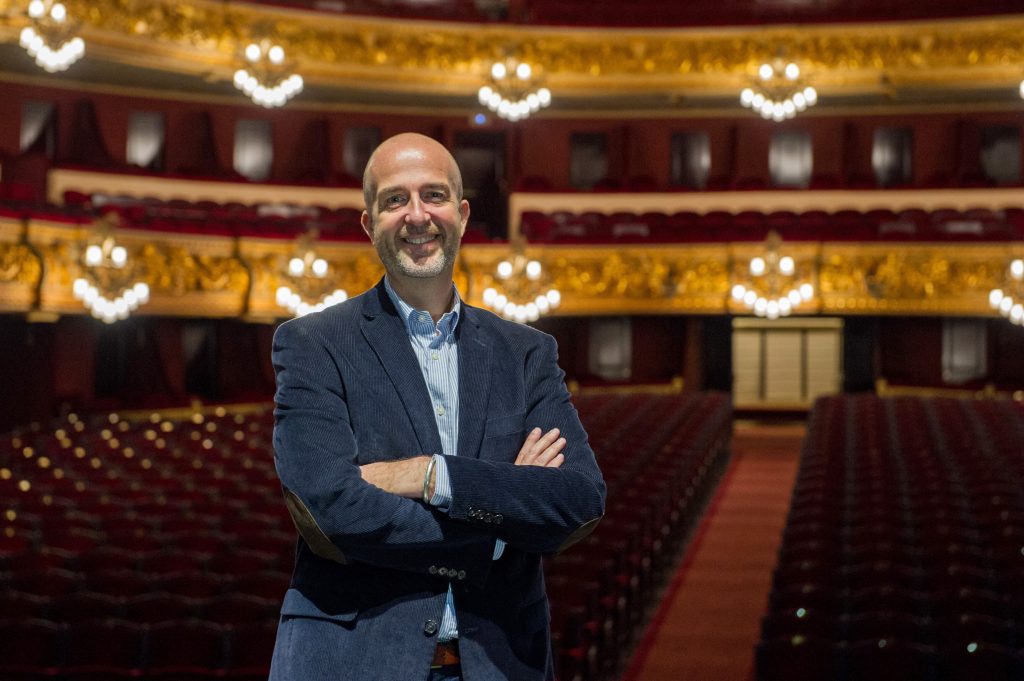
Víctor García de Gomar, current artistic director of the Liceu. Photo: Antoni Bofill, courtesy of the theater.
Today, the Gran Teatre del Liceu stands out as the largest opera house in the world. Its capacity is 2,292 seats and contains five amphitheaters, which, in parallel to other spaces such as the Sala Gran, the foyer and the Saló des Miralls (“Hall of Mirrors”), make it a beautiful bastion of culture, music and the drive for programmatic and infrastructure excellence.
Photo: Annals of the Gran Teatre del Liceu
With a life that already spans 175 years, the Liceu has known of tragedies, processes of social and political transformation and an institutional and cultural renown that is inseparable from its busy history. Now, the Main Hall is a faithful replica of the original Hall, a sublime evocation of the long tradition that this Theater proudly carries. And it is not only a tradition marked by the network of devotion and festive spirit celebrated by an entire society. It is a resilience that stands firm in the La Rambla neighborhood. More than a theater, the Liceu is a story told through different lives.
For more information about the history of the Liceu, you can enter the Annals, where documents and material corresponding to its different seasons are collected. Enter here.


